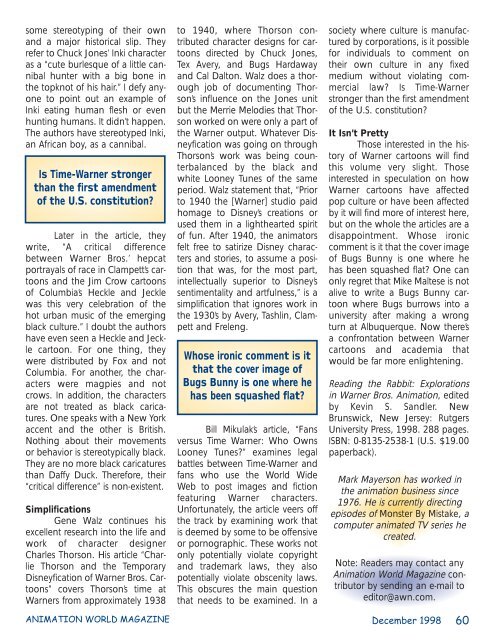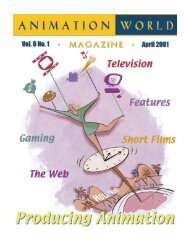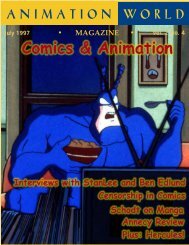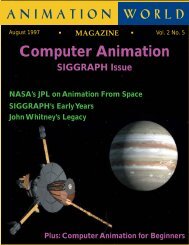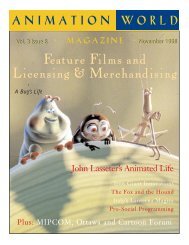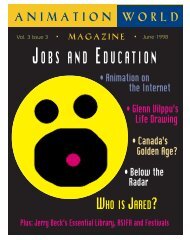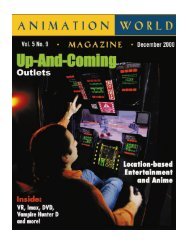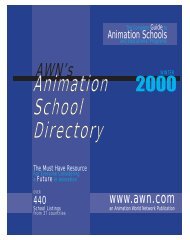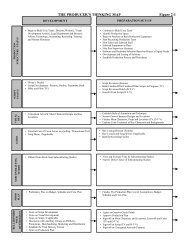Amusement Parks & Family Entertainment Amusement Parks
Amusement Parks & Family Entertainment Amusement Parks
Amusement Parks & Family Entertainment Amusement Parks
Create successful ePaper yourself
Turn your PDF publications into a flip-book with our unique Google optimized e-Paper software.
some stereotyping of their own<br />
and a major historical slip. They<br />
refer to Chuck Jones’ Inki character<br />
as a “cute burlesque of a little cannibal<br />
hunter with a big bone in<br />
the topknot of his hair.” I defy anyone<br />
to point out an example of<br />
Inki eating human flesh or even<br />
hunting humans. It didn’t happen.<br />
The authors have stereotyped Inki,<br />
an African boy, as a cannibal.<br />
Is Time-Warner stronger<br />
than the first amendment<br />
of the U.S. constitution?<br />
Later in the article, they<br />
write, “A critical difference<br />
between Warner Bros.’ hepcat<br />
portrayals of race in Clampett’s cartoons<br />
and the Jim Crow cartoons<br />
of Columbia’s Heckle and Jeckle<br />
was this very celebration of the<br />
hot urban music of the emerging<br />
black culture.” I doubt the authors<br />
have even seen a Heckle and Jeckle<br />
cartoon. For one thing, they<br />
were distributed by Fox and not<br />
Columbia. For another, the characters<br />
were magpies and not<br />
crows. In addition, the characters<br />
are not treated as black caricatures.<br />
One speaks with a New York<br />
accent and the other is British.<br />
Nothing about their movements<br />
or behavior is stereotypically black.<br />
They are no more black caricatures<br />
than Daffy Duck. Therefore, their<br />
“critical difference” is non-existent.<br />
Simplifications<br />
Gene Walz continues his<br />
excellent research into the life and<br />
work of character designer<br />
Charles Thorson. His article “Charlie<br />
Thorson and the Temporary<br />
Disneyfication of Warner Bros. Cartoons”<br />
covers Thorson’s time at<br />
Warners from approximately 1938<br />
to 1940, where Thorson contributed<br />
character designs for cartoons<br />
directed by Chuck Jones,<br />
Tex Avery, and Bugs Hardaway<br />
and Cal Dalton. Walz does a thorough<br />
job of documenting Thorson’s<br />
influence on the Jones unit<br />
but the Merrie Melodies that Thorson<br />
worked on were only a part of<br />
the Warner output. Whatever Disneyfication<br />
was going on through<br />
Thorson’s work was being counterbalanced<br />
by the black and<br />
white Looney Tunes of the same<br />
period. Walz statement that, “Prior<br />
to 1940 the [Warner] studio paid<br />
homage to Disney’s creations or<br />
used them in a lighthearted spirit<br />
of fun. After 1940, the animators<br />
felt free to satirize Disney characters<br />
and stories, to assume a position<br />
that was, for the most part,<br />
intellectually superior to Disney’s<br />
sentimentality and artfulness,” is a<br />
simplification that ignores work in<br />
the 1930’s by Avery, Tashlin, Clampett<br />
and Freleng.<br />
Whose ironic comment is it<br />
that the cover image of<br />
Bugs Bunny is one where he<br />
has been squashed flat?<br />
Bill Mikulak’s article, “Fans<br />
versus Time Warner: Who Owns<br />
Looney Tunes?” examines legal<br />
battles between Time-Warner and<br />
fans who use the World Wide<br />
Web to post images and fiction<br />
featuring Warner characters.<br />
Unfortunately, the article veers off<br />
the track by examining work that<br />
is deemed by some to be offensive<br />
or pornographic. These works not<br />
only potentially violate copyright<br />
and trademark laws, they also<br />
potentially violate obscenity laws.<br />
This obscures the main question<br />
that needs to be examined. In a<br />
society where culture is manufactured<br />
by corporations, is it possible<br />
for individuals to comment on<br />
their own culture in any fixed<br />
medium without violating commercial<br />
law? Is Time-Warner<br />
stronger than the first amendment<br />
of the U.S. constitution?<br />
It Isn’t Pretty<br />
Those interested in the history<br />
of Warner cartoons will find<br />
this volume very slight. Those<br />
interested in speculation on how<br />
Warner cartoons have affected<br />
pop culture or have been affected<br />
by it will find more of interest here,<br />
but on the whole the articles are a<br />
disappointment. Whose ironic<br />
comment is it that the cover image<br />
of Bugs Bunny is one where he<br />
has been squashed flat? One can<br />
only regret that Mike Maltese is not<br />
alive to write a Bugs Bunny cartoon<br />
where Bugs burrows into a<br />
university after making a wrong<br />
turn at Albuquerque. Now there’s<br />
a confrontation between Warner<br />
cartoons and academia that<br />
would be far more enlightening.<br />
Reading the Rabbit: Explorations<br />
in Warner Bros. Animation, edited<br />
by Kevin S. Sandler. New<br />
Brunswick, New Jersey: Rutgers<br />
University Press, 1998. 288 pages.<br />
ISBN: 0-8135-2538-1 (U.S. $19.00<br />
paperback).<br />
Mark Mayerson has worked in<br />
the animation business since<br />
1976. He is currently directing<br />
episodes of Monster By Mistake, a<br />
computer animated TV series he<br />
created.<br />
Note: Readers may contact any<br />
Animation World Magazine contributor<br />
by sending an e-mail to<br />
editor@awn.com.<br />
ANIMATION WORLD MAGAZINE December 1998 60


